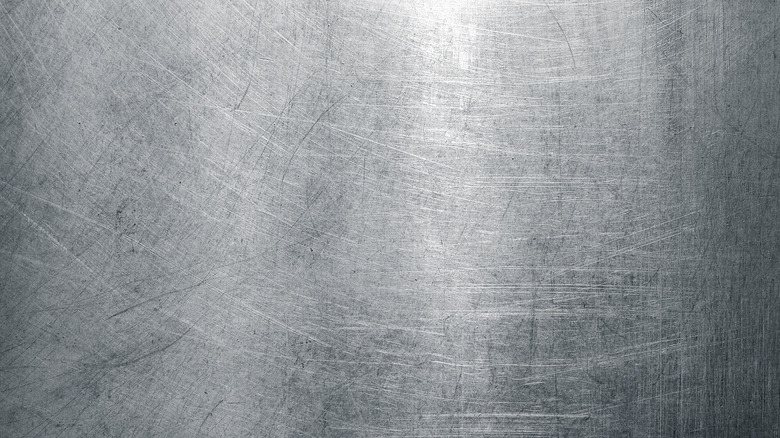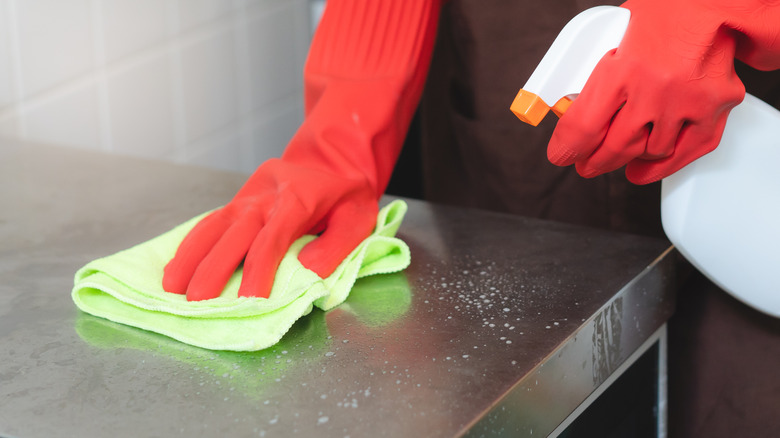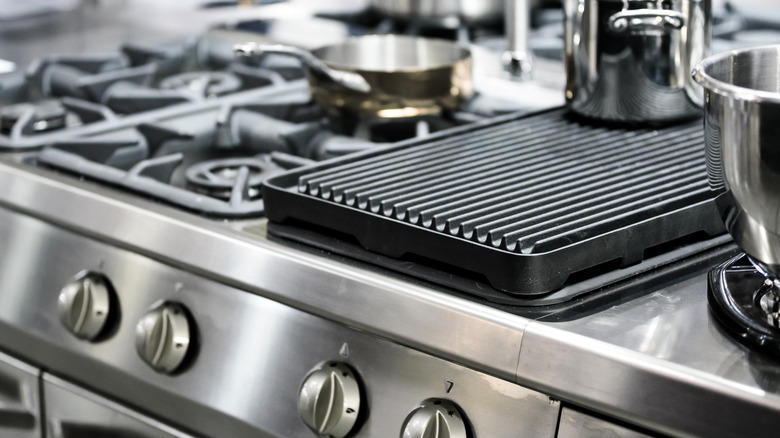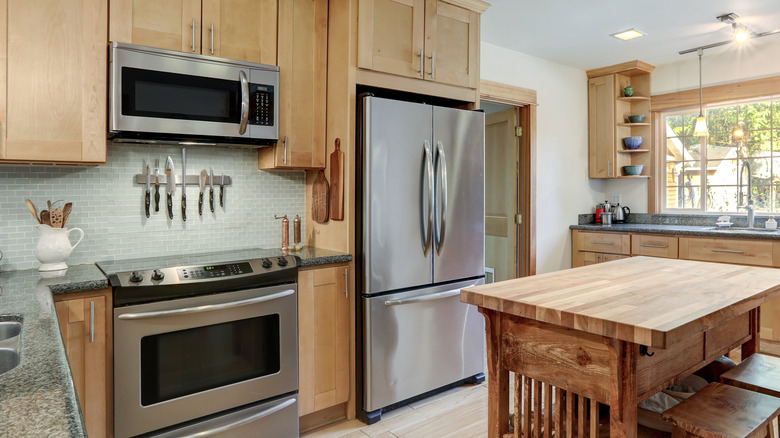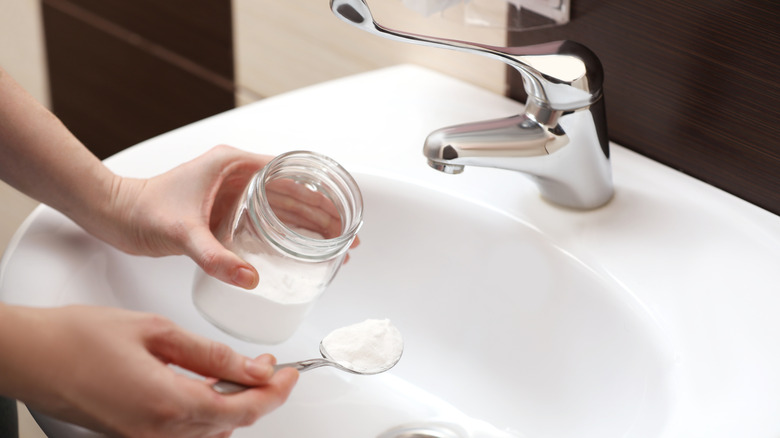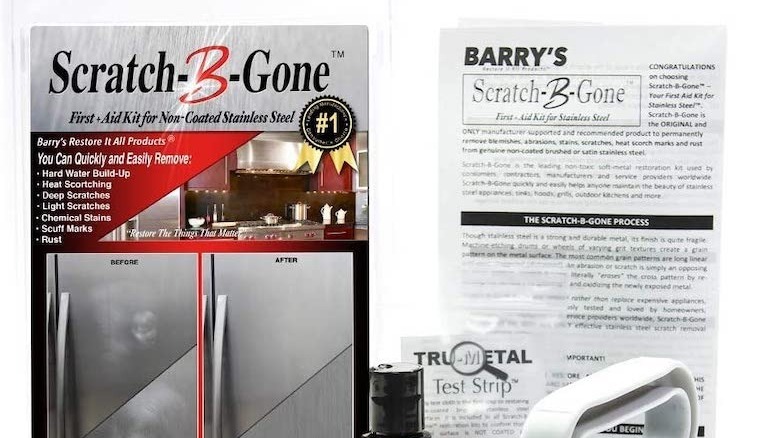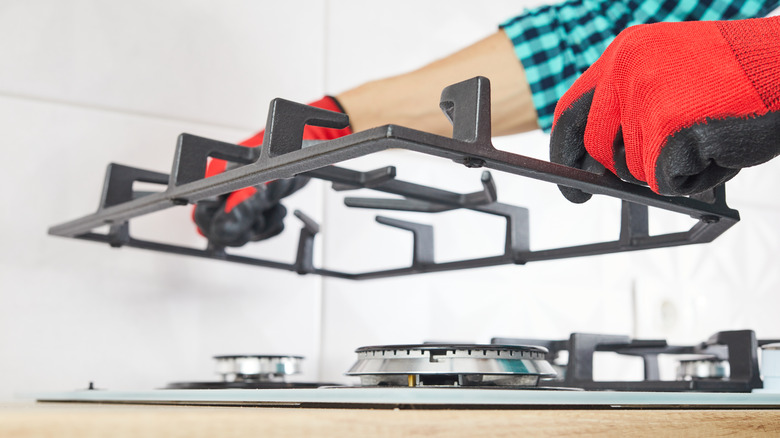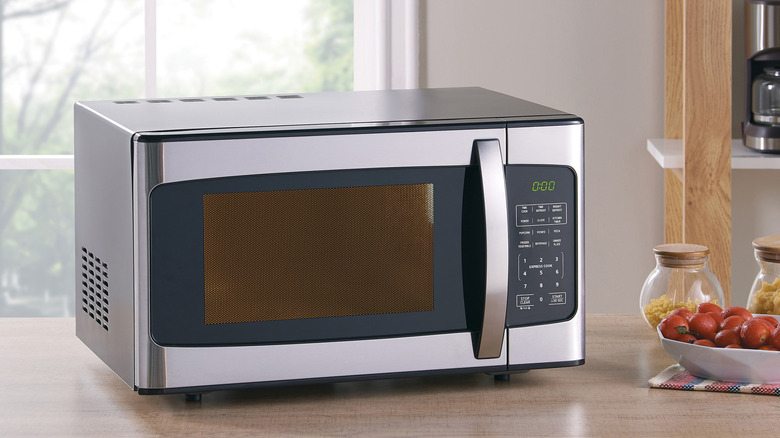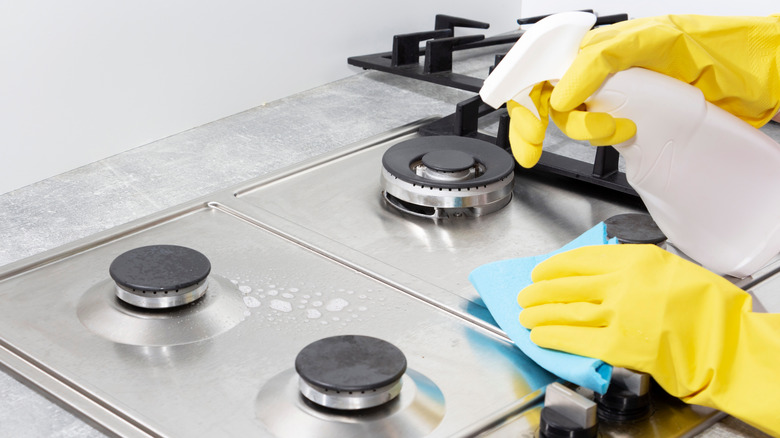How To Fix Scratches On Stainless Steel
We may receive a commission on purchases made from links.
Stainless steel is one of the most modern and durable metal materials folks enjoy using and seeing in their home. It makes everything look clean and sleek, from kitchen appliances to interior wall panels. Although stainless steel is a sturdy metal, it's prone to unwanted scratches from everyday use. From afar you wouldn't notice the brush streaks, but up-close, away from the reflective light, you might be able to spot them.
The brush streaks on the surface are known as the grain, according to BobVila. The grain could run in any direction, either up and down or side-to-side. When treating scratches, make sure to rub in the direction of the grain and never perpendicular or in a circular motion, as that could cause more harm. Also, it's best to determine whether or not the scratched appliance has a clear coat over the stainless steel. If it does, you'll need to use a different treatment in order to ensure you don't cause more damage to the metal.
Use a non-abrasive cleaner
Perfect for light scratches, a non-abrasive cleaner will smooth out the grain on stainless steel in little to no time, according to Mr. Appliance. Non-abrasive cleaners are available in both powder and liquid forms. The cleaner works by filling in fine lines to smooth out the steel surface. Some liquid non-abrasive products you can purchase are from Bar Keeper's Friend, Weiman, and Method.
When using a non-abrasive cleaner, follow these steps from Mr. Appliance. If you're using a powder formula, start by mixing it with some water to create a paste for easier cleaning. With a small amount of the paste on a damp microfiber washcloth, rub back and forth over the scratch following the direction of the grain. Once you've rubbed it a few times, use a new, clean damp cloth to wipe away the excess paste. Check to see if the scratch was removed. If not, repeat the process until it has disappeared. When the surface is cleaned up, apply a coat of stainless steel polish or olive oil to give it a satisfying shine.
Use a whitening toothpaste
If the powder mixture you tried doesn't work on light scratches, Hunker suggests using a little bit of whitening toothpaste, which is mildly abrasive. Toothpaste can also be used on semi-deep scratches, in addition to remedying lighter scratches. You'll want to make sure the surface is clean beforehand, free from any oils or dirt — you can first clean the surface with a vinegar solution, rinse it off, and dry it with a soft towel.
Apply the toothpaste to a toothbrush and brush over the scratches, following the grain. To check your progress, you can wipe away the toothpaste with a damp cloth and re-examine the surface. If scratches persist, reapply the toothpaste and repeat the process until you are satisfied that the scratches have subsided. Once you've finished, clean the surface with a stainless steel-friendly formula, and apply a coat of stainless steel polish or olive oil.
Use sandpaper for deeper scratches
Light scratches are easier to fix than deeper ones, but it is possible to fix more severe scratches as well. One method is to sand down the scratches with sandpaper and a kitchen oil, such as olive oil. For this method to work, the surface needs to be free of any clear coat, otherwise, you may unwittingly cause more damage. There are kits that are made to help fix deeper scratches, but sources such as This Old House state that DIY methods such as this can be effective as well. Gather your fine-grit sandpaper and olive oil and you'll be ready to get started.
Add a few drops of oil to the sandpaper, and over the scratch. You may also need to keep adding drops throughout the cleaning process. Applying moderate pressure, rub the sandpaper back and forth along the grain. After you sand down the surface of the scratch, use a finer grit paper to buff the affected area. When finished, wipe down the surface with a clean, damp towel and dry with a soft microfiber cloth. Repeat the process until you're happy with the results.
Use baking soda
If you don't want to invest in new chemical cleaners, you can try using some baking soda you happen to have on hand, as recommended by HowStuffWorks. Just like the whitening toothpaste we mentioned previously, baking soda is slightly abrasive, so it'll help get rid of light and moderate scratches on your stainless steel appliances. Baking soda comes in powder form, so be prepared to mix it with a little bit of water in order to create a paste.
Once you've mixed things up, add a thin layer of the paste you just formed over the spot where the scratch is. Use a cloth to scrub it gently, again keeping in mind the direction of the grain — you won't want to accidentally make the small scratch into a bigger problem. After you feel that the scratch has disappeared, wipe away the remaining baking soda with a wet washcloth. If the scratch is still there, add another layer of baking soda and treat the area until you can no longer see it.
Using a stainless steel repair kit
If you're unsure of whether or not the non-abrasive cleaners will do the trick, you can opt for a stainless steel scratch repair kit. These kits provide you with everything you will need to get rid of scratches big and small, without having to research various methods or cleaners. Hunker recommends the Scratch-B-Gone kit, and at the time of publishing, Amazon lists it for sale for just $51.95. It comes with eight items: a patented grip handle, a gray finishing pad, a brown finishing pad, a burgundy foam-backed pad, a coarse abrasive finger strip, a trumetal test strip, an ultra shine bottle, and a microfiber cloth. Amazon also provides step-by-step instructions before you buy.
Use the trumetal strip to determine whether the appliance is coated or not — non-coated surfaces will turn black. Next, determine the depth of the scratch to figure out which pad to use. If it's just a surface scratch, use the gray pad. If you can feel a small indent, use the brown pad, and if you dig your fingernail into the scratch, try the burgundy pad. Attach your pad to the handle, and apply the Ultra Shine formula. Move the handle up and down over the scratch, along the grain. Repeat that motion ten times and then clean using the microfiber cloth.
Get help from a profession repair service
Oftentimes, small, faint scratches are easier to fix with a few home products, but the deep scratches may require more care. Depending on the severity of the scratch, you'll likely be able to at least determine if you can fix it on your own with an at-home kit. If you come across something more intimidating, however, there are professionals who can help. Though it can be a costly route to take, it may be better than taking a risk on your own.
Professional stainless steel repair and restoration companies have the right tools and experience to take on your repair. Companies such as Scratch Off Stainless offer free repair quotes through their website and can estimate how long it will take to get the job done. Their reviews claim that their technicians are friendly, fast, and efficient. The American Metal Restoration company is another great source to contact for a free repair quote. They can help you via email once you send them a few photos and some information describing the issue.
Removing scratches from coated stainless steel
Scratch removal methods are fairly similar for coated and non-coated stainless steel appliances, but you should know the difference so you can take care not to cause extra damage when cleaning or removing scratches. Coated stainless steel appliances are finished with a synthetic clear coat for additional protection, according to HomeSteady. If you're unsure if your stainless steel surface is coated or non-coated, you can use a trumetal strip test to find out. Once you've determined that it's coated, you can proceed to use a metal polishing product to remove any scratch, according to Upgraded Home.
The steps are similar to those for treating non-coated stainless steel appliances. Clean the surface thoroughly, making sure there's no lingering grease or dirt. Apply the metal polishing paste to a microfiber cloth and gently rub in a circular motion over the scratch. Before the scratch dries, grab a clean soft cloth and buff the scratch in the direction of the grain with the paste.
Tips to keep appliances clean and scratch free
Trying to make scratches disappear from your appliances can be time-consuming, which is why it's easier to prevent the scratches from forming in the first place. Practicing regular cleaning can help keep your stainless steel appliances looking sharp for longer. This will also prevent a significant build-up of dirt and grime, which might prompt harsher scrubbing that can cause scratches. However, BobVilla warns against regular cleaning with abrasive formulas or bleach because they can corrode the metal and lead to rusting. When using non-abrasive cleaners, always make sure to rub in the direction of the grain to prevent scratches. If you forget any of these tips, you can refer to the user manual that comes with the appliance when you first buy it.
HowStuffWorks recommends using warm water for a simple yet effective clean that won't harm the metal. Just make sure you're not using hard water, or else you may leave water stains behind. You can also put undiluted white vinegar in a spray bottle and use that to clean the surfaces. The vinegar's acidity cuts through stains from hard water and heat. Glass cleaners such as Windex will also work to get rid of unwanted and unsightly fingerprints you may notice on your stainless steel appliances.

